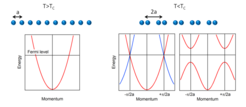
Strong Correlations in One-Dimensional Metallic Wires
In low-dimensional metals the total energy of the system can be lowered by a periodic distortion of the crystal lattice. This phase transition is referred to as a Peierls transition, and is accompanied by an increase in the size of the unit cell and a redistribution of the charge density through electron-phonon coupling. The increase of the size of the unit cell results in a decrease of the size of the Brillouin zone in reciprocal space, and hence to a backfolding of bands at the new Brillouin zone boundaries. At the points where the backfolded bands intersect the original bands, new band gaps will open up. If these band gaps lie at the Fermi level, the system will undergo a metal-to-insulator transition. The formation of such a charge density wave (CDW) ground state is accompanied by the appearance of novel collective excitations that are termed amplitude and phase mode.
In the case of a Peierls transition the metal-to-insulator transition is driven by electron-phonon coupling. A similar metal-to-insulator transition occurs in systems with strong electron-electron interactions, where the mutual repulsion of electrons in a half-filled band leads to the localization of charge carriers and the formation of a Mott insulator.
We investigate the CDW physics in one-dimensional metallic chains that can be grown in situ on vicinal silicon substrates. Among these systems, gold wires are of particular interest as they exhibit a Rashba-type spin splitting of the one-dimensional states (see below) in addition to the periodic lattice distortion, which might allow for light-control of the electron spin.

